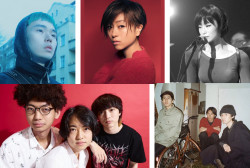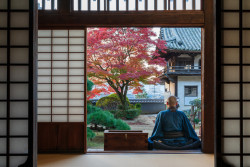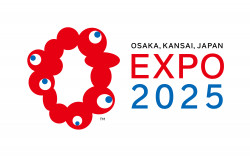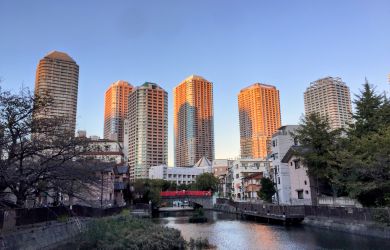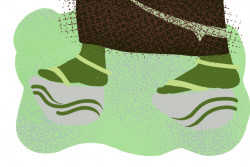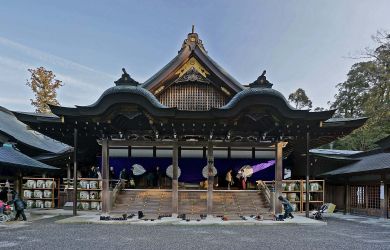
September 30, 2010
Green Light
A new breed of foreign filmmakers find alternative ways to fund their Japan-based movies
By Metropolis
Originally published on metropolis.co.jp on September 2010

Clockwise from top left: Courtesy of Ivy Oldford; promotional trailers for Amerika: A Notebook in Three Parts ©Arcanum Productions; Courtesy of Ivy Oldford; promotional trailers for Amerika: A Notebook in Three Parts ©Arcanum Productions
It’s never been easy to become a filmmaker in any country—and this is especially true in Japan. Historically, Japanese film directors were viewed as little more than employees of their studios, and even the great Akira Kurosawa had to serve a six-year apprenticeship before being allowed to step behind the camera.

Iranian director Amir Naderi (left) on the set with producers Eric Nyari (center) and Engin Yenidunya
Courtesy of Tokyo Story
Foreign filmmakers, too, have had little choice but to partner with local studios and work within their system, often leading to big-budget debacles like The Bad News Bears Go to Japan (1978). This began to change in the post-bubble ’90s, when the strength of the Japanese studio system eroded, giving birth to independent films funded not by a single studio, but a handful of corporate sponsors. Gradually, more foreign filmmakers began to trickle in—Sofia Coppola cut corners and skirted filming permits, stealing shots of Shibuya crossing for 2003’s Lost in Translation by positioning her cinematographer in the window of Starbucks.
Then the industry was dealt another blow when the “Lehman shock” decimated the global economy in late 2008. Suddenly, corporations were no longer so interested in investing in anything as risky as film production. But artists, especially the aspiring kind, can be the most determined people on earth. As Tokyo remains a popular setting, foreign filmmakers aren’t sitting around waiting for executives in big offices to green-light their projects. Instead, they’re taking matters into their own hands and inventing new ways to get their Japan-based films made.

Courtesy of Tokyo Story
“I wouldn’t say the fundraising model has changed,” says Engin Yenidunya, a banker by day and film producer by night. “It is more accurate to say that less films are being made because the model has not been changed. What we are trying to do is bring in an American style of fundraising in order to get our projects realized.”
The 30-year-old native of Turkey is a partner, along with Eric Nyari and Regis Arnaud, in Tokyo Story, a production company founded in 2007. Yenidunya and Nyari got their start within the film world by co-producing Wakiyaku Monogatari (“Cast Me If You Can”), a Japanese-language comedy that opens in theaters this month. Next up is Cut, a drama about a young Japanese film director, by critically-acclaimed Iranian filmmaker Amir Naderi.
“The way we are raising the budget is not usually done in Japan,” Yenidunya explains at Havana Cafe, a Cuban bar near Tokyo Midtown where he holds informal weekly gatherings for the film’s crew, investors and supporters. “These meetings are a way of appealing to potential investors, but they are also a way of building interest in the film.”
As a laptop computer runs a slideshow of stills from the set, people chat with the producers about how the filming is going. The three founders of Tokyo Story have all personally invested in the projects, though much of the funding has come from friends and associates. “We tell people that if they lose 50 percent, we do too, and if they get back 150 percent, we do too,” Yenidunya says. “Of course, we do not want anyone to put in their life savings.”

Ivy Oldford, director of the short dance film Handbag
Courtesy of Ivy Oldford
Tokyo Story also plans to raise a portion of the budget through corporate sponsors. Thanks to a high-profile cast and big-name collaborators, including directors Shinji Aoyama and Kiyoshi Kurosawa, Cut has also won financial support from the Pusan International Film Festival, one of the most significant festivals in Asia.
Of course, not all filmmakers have the luxury of being able to wait for prestigious film fests to knock at their door with offers of financial support. Ivy Oldford, a filmmaker recently arrived in Tokyo from her native Canada, directed the seven-minute short Handbag, about a furtive relationship between a salaryman and a schoolgirl—told not through dialogue but tango dance.
“We filmed it in Tokyo, mostly while running away from security guards,” she recalls with a laugh. Handbag will premiere this month at the Sapporo International Short Film Festival, and has been accepted into Cinefilia Tanguera, a travelling festival of tango-related films. Oldford hopes the short will help open doors for a feature film that she also plans to shoot in Japan. “This particular dance short is, rather than a calling card, something to get prospective collaborators interested in my work in general,” she explains.
Another filmmaker starting on a small scale with an eye to moving on to bigger things is American director Mika Johnson, who is producing his debut feature film, Amerika: A Notebook in Three Parts, in a new process that’s been referred to as “reserve filmmaking.” The New York-based director has already made a pair of trailers—even though he has yet to shoot a single frame of the actual film. The trailer, which is usually the last stage of the production process, was made on a budget of less than $5,000 with the help of volunteer actors, student interns and equipment borrowed from the director’s alma mater, Oberlin University in Ohio.
Amerika tells the story of a Japanese woman in search of her father, leading her on a journey through the US and into Japan. Johnson plans to shoot in three phases, two in the US and one in Japan, with fundraising between each stage. The trailers are but the first step in the process. “The promotional trailers give visitors a glimpse into the film’s unique message and aesthetic,” he explains.

Mika Johnson ©Arcanum Productions
Johnson is no stranger to filming in Japan, having directed a 30-minute short, Mountain of Signs (2003), in Tokyo and Mount Koya, the center of Shingon Buddhism in Wakayama Prefecture. In order to win seldom-granted permission to shoot at Kongobuji Temple, the filmmaker befriended a local monk. Johnson is employing the same resourcefulness to produce his first feature—he shot the trailer in Ohio, not merely to cut costs and take advantage of a 25 percent tax credit, but also as a means of reducing the environmental impact of the production and aligning the project with a variety of green initiatives.
“Our food was locally sourced, seasonal and vegetarian,” he explains. “We carpooled. We stuck to a no-plastic-bottle rule. We built our only set using only recycled materials, and we left each location just as we’d found it. We also shared our methods online, so as to provide other eco-conscious filmmakers with sustainable and adaptive filmmaking solutions.” These efforts have helped build grassroots support for the project.
Johnson is one of a new generation of filmmakers promoting their projects online before they are even made. “We wanted to experiment with the possibilities of the internet, both as a distribution source and a medium that can educate and inspire people to act,” he says. “We added subtitles to the trailers, in Arabic, Japanese and Chinese, and made them the cinematic centerpiece of a multi-platform social awareness and activist initiative.” The film’s website features essays on water pollution and conservation, central themes of the film.
Another filmmaker turning to the internet to raise funds is John Jeffcoat, a US director who has been on something of a winning streak. His award-winning debut film, Outsourced, a romantic comedy about an American businessman training a call center in India, has been adapted as a TV series, due to air this fall on American network NBC in a prime slot after The Office. He was also tapped to produce the Seattle segments of the new MTV show $5 Cover.

Courtesy of John Jeffcoat
In light of such success, it might seem easy for Jeffcoat to secure financing for his next project, Big in Japan, a documentary about a Seattle garage band with dreams of rock stardom in Tokyo. But working without a script with non-actors makes for a hard sell, and when funding was pulled, he went online.
“I’d thrown some money to a few friends’ films when they started Kickstarter.com campaigns, and I was surprised how well it seemed to work,” the director says, referring to an online community that brings together creators and investors. Jeffcoat and the band, Tennis Pro, registered a project on the site with the goal of raising $10,000 for travel expenses. Within a month, they had surpassed that total by $1,500. “Not only did we raise the money, but it helped get the word out about the project, and several of the people donating money contacted us about funding the rest,” he says.
Another creator going the Kickstarter route is American Brad Kremer, who has traveled the world producing sports photography and films. During his downtime on a snowboarding shoot in Japan in 2009, he began experimenting with time-lapse photography of mountain landscapes, as well as the crowded intersections of Shibuya. He compiled the results into an eight-minute short, Hayaku, intending it as a gift to his Japanese wife’s family. When he uploaded the film to the video sharing site Vimeo, however, it received over 250,000 views in the first month.

John Jeffcoat and Seattle rock band Tennis Pro hope to make it Big in Japan
Courtesy John Jeffcoat
“The response I got was absolutely amazing,” Kremer recalls. “It blew me away that it really seemed to touch people’s hearts. I got countless emails from people who know Japan and people who don’t know Japan, but just loved it.”
Kremer hopes to turn Hayaku into a feature-length film that combines slow motion, real-time and time-lapse photography, with the goal of “making people notice the things they miss in daily life.” He’s posted a project on Kickstarter in the hopes of raising funds to make three trips to Japan in three different seasons.
As with most Kickstarter projects, Kremer’s offers different levels of sponsorship, ranging from $5 to $10,000, with gifts like DVDs or signed movie posters to supporters when it is completed. These incentives, along with the desire to help someone make their dream come true, inspire contributors to open their wallets.
Online communities and video streaming aren’t the only technologies helping filmmakers. Advances in digital cameras and desktop editing and composition software allow Kremer to work as a one-person film crew. Meanwhile, Jeffcoat is planning to shoot Big in Japan on a Canon 5D Mark II, a digital still camera which filmmakers have been reverse engineering to capture broadcast-quality video. The Canon camera retails for around ¥340,000—not pocket change, but less than what it would cost to rent a 35mm film camera for a weekend. As technology advances and filmmakers continue to invent new ways to use it, we can look forward to an era in which anyone who has a story to tell in Japan, and the drive to do so, will be able to bring their vision to the screen.
Filmmaker Resources
KICKSTARTER

Described as a “new way to fund creative ideas and ambitious endeavors,” Kickstarter lets creators describe their project and how much money they need to complete it. If they raise the money by a given deadline, contributors are charged through the Amazon Payments system. If not, no money changes hands. Successfully funded projects tend to convey an exciting idea clearly and give a sample of what’s to come. www.kickstarter.com
WITHOUT A BOX

Getting a film into a festival is frequently key to raising funds for future projects. Unfortunately, new filmmakers often spend more time submitting their work to festivals than actually filming. Without a Box streamlines the process by allowing you to pay submission fees and send press kits and even full movies, all online. www.withoutabox.com
JAPAN FOUNDATION

The Japan Foundation awards grants of up to half of production costs for documentary films and TV programs on Japanese subjects. Funds are not granted until after the project is completed, but being associated with the Foundation adds prestige that encourages other investors. www.jpf.go.jp
